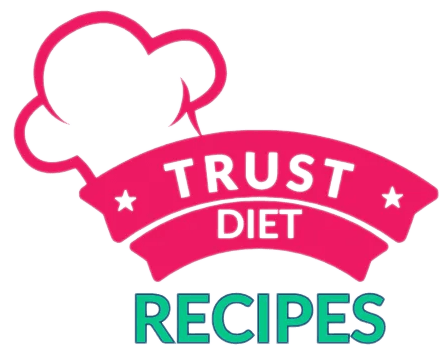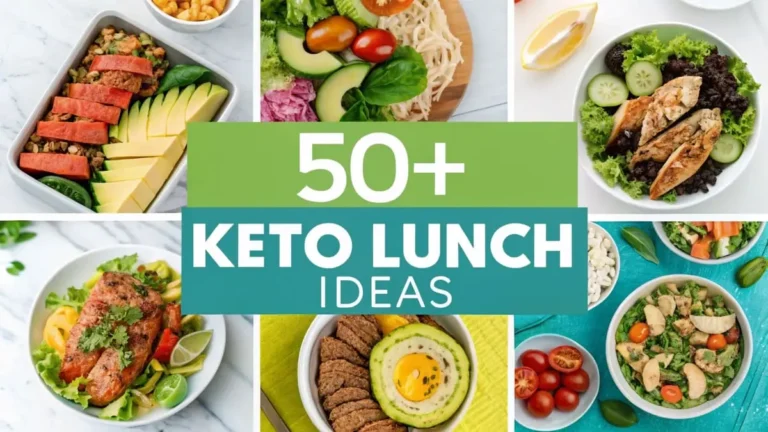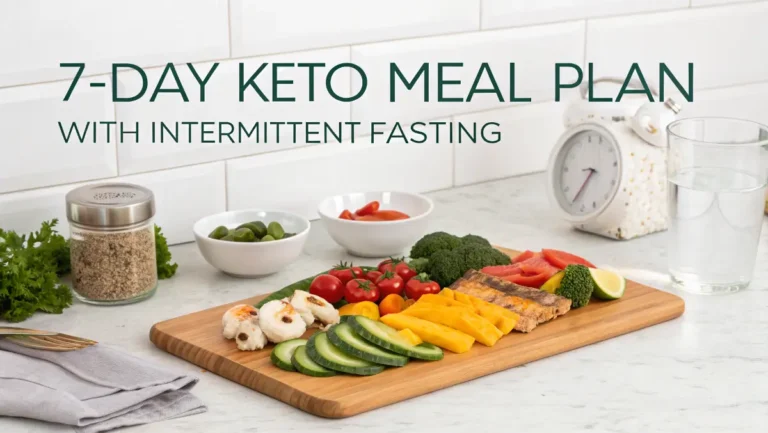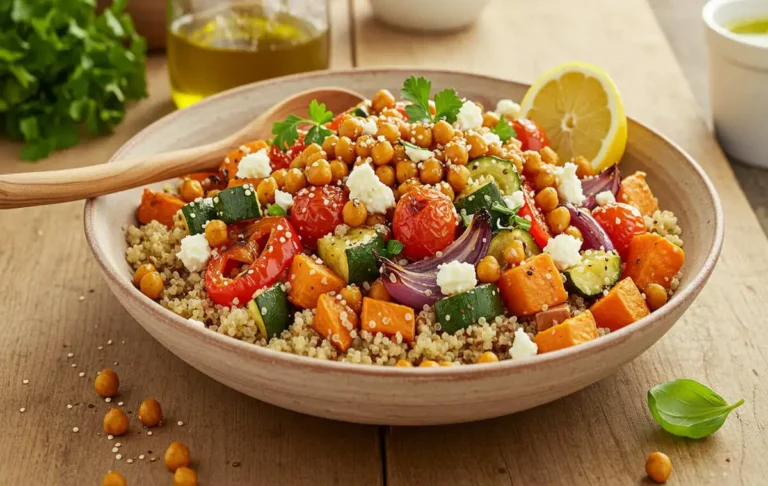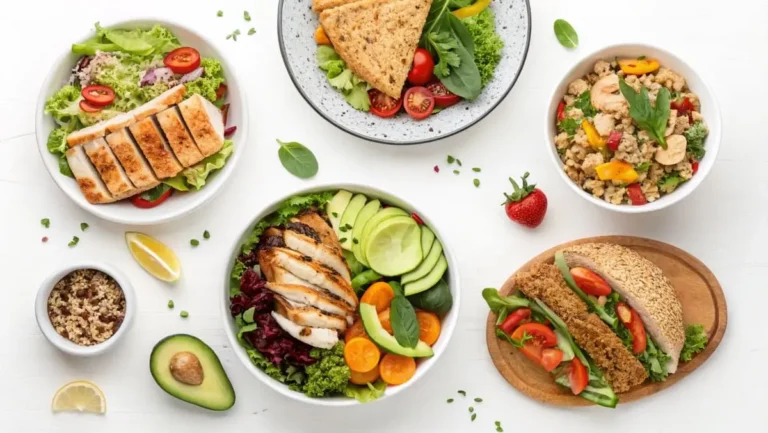7-Day Keto Meal Plan for Beginners
Welcome to your journey towards a healthier you with a beginner keto meal plan! This guide is here to help you start your low-carb journey. It offers delicious and easy-to-follow recipes.

You’ll learn how to begin with the ketogenic diet. You’ll know what to eat and what to avoid. Plus, you’ll find simple meal prep strategies for keto success. By following this 7-day keto meal plan for beginners, you’ll be on your way to reaching your weight loss goals.
Key Takeaways
- Understand the basics of the ketogenic diet
- Learn what foods to eat and avoid on a keto diet
- Discover simple meal prep strategies for keto success
- Get a complete 7-day meal plan to kickstart your journey
- Achieve your weight loss goals with a well-planned keto diet
Table of Contents
Understanding the Ketogenic Diet
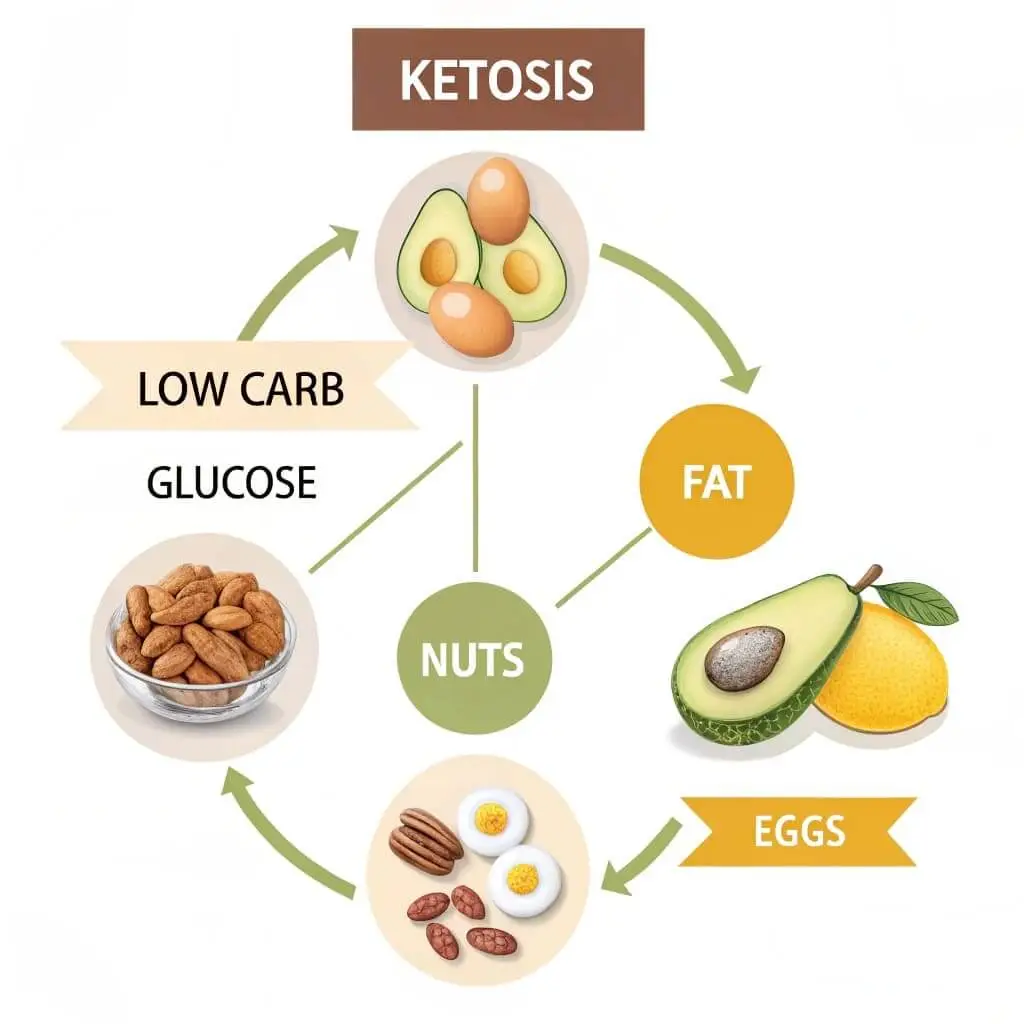
Getting to know the ketogenic diet is the first step to its benefits. It’s a diet low in carbs and high in fats. It helps with weight loss and boosts health. By cutting down carbs, your body enters ketosis.
What is Ketosis and How Does it Work?
Ketosis is when your body uses fat for energy instead of carbs. This happens when you eat fewer carbs and more fats. Your body then burns fat, leading to weight loss. A good ketogenic meal plan can help you get into ketosis.
- Reduces carbohydrate intake
- Increases fat consumption
- The body burns fat for energy
Health Benefits of a Keto Diet
The keto diet has many health perks, like weight loss and better blood sugar control. By following a healthy, low-carb, no-cook 7-Day meal plan, you can see these benefits. Key advantages include:
- Weight Loss: The keto diet burns fat for weight loss.
- Improved Blood Sugar Control: It helps manage blood sugar levels.
- Increased Energy: High-fat diets give lasting energy.
Understanding and using a keto diet meal prep helps you smoothly start this diet. It’s not just about cutting carbs. It’s about adopting a healthy eating plan for better well-being.
Getting Started with Your 7-Day Keto Meal Plan for Beginners
Starting a keto diet needs good planning and the right tools. Knowing how to figure out your macros and having the right kitchen tools are key steps.
Calculating Your Macros
Figuring out your macronutrients, or “macros,” is key for a keto diet. You should eat lots of fat, some protein, and very few carbs. To find your macros, first figure out how many calories you need each day. Then split those calories into fats, proteins, and carbs.
A good keto diet mix is 70-80% fat, 15-20% protein, and 5-10% carbs.
| Macro | Percentage | Grams (based on 2000 calories) |
|---|---|---|
| Fat | 70-80% | 155-178g |
| Protein | 15-20% | 75-100g |
| Carbohydrates | 5-10% | 25-50g |
Essential Kitchen Tools for Keto Cooking
Having the right kitchen tools makes keto cooking simpler and faster. You’ll need a digital kitchen scale for measuring, a large skillet for cooking, and a slow cooker for meal prep. A food processor is also useful for making keto-friendly sauces and dips.
With these tools and knowing your macros, you’re set to begin your keto journey. Next, we’ll look at keto-friendly foods to eat and avoid.
Keto-Friendly Foods: What to Eat and What to Avoid
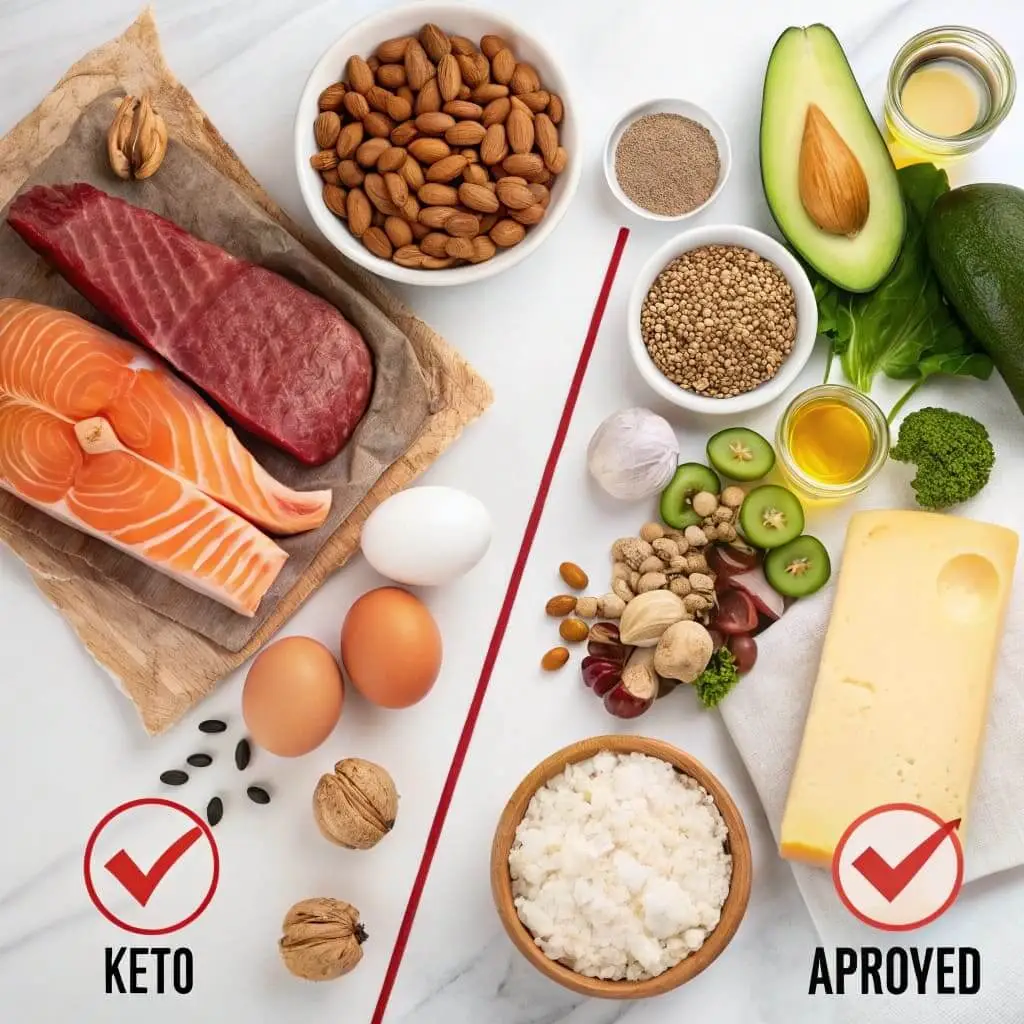
Starting a keto diet means knowing which foods to eat and which to avoid. It’s important to pick the right foods to stay in ketosis.
Approved Keto Foods List
Stick to whole, nutrient-rich foods to keep your body in ketosis. Your meal prep should include:
- Meats: beef, pork, lamb, and poultry
- Fatty fish: salmon, tuna, and mackerel
- Eggs: a versatile and keto-friendly option
- Full-fat dairy: cheese, butter, and full-fat cream
- Low-carb vegetables: leafy greens, broccoli, cauliflower, and avocado
- Nuts and seeds: almonds, walnuts, chia seeds, and flax seeds
- Healthy oils: olive oil, coconut oil, and avocado oil
These foods are packed with nutrients and support a low-carb lifestyle. This makes meal planning easier.
Foods to Eliminate on Keto
Knowing what not to eat is just as key as knowing what to eat. To stay in ketosis, avoid:
- Sugary foods: candy, cakes, and sweetened beverages
- Grain-based foods: bread, pasta, rice, and cereals
- Starchy vegetables: potatoes, corn, and peas
- Legumes: beans, lentils, and peanuts
- Low-fat or diet products: often high in sugar and unhealthy carbs
- Unhealthy fats: processed meats and foods with artificial additives
By choosing the right foods and avoiding the wrong ones, you’ll reach your diet goals. Enjoy the benefits of a well-planned keto diet.
Smart Grocery Shopping for Keto
Having a good keto grocery list is key to success. When starting keto, knowing how to shop is important. It’s not just about picking keto foods; it’s about finding a shopping plan that fits your budget and lifestyle.
Creating a Budget-Friendly Keto Shopping List
To make a budget-friendly keto shopping list, first, list the essential keto ingredients. Look for whole foods like meats, fish, eggs, full-fat dairy, oils, and veggies. These foods are good for keto and are full of nutrients.
Plan meals around these basics to cut down on waste and save money. Buying in bulk and choosing cheaper meat cuts can help. Also, buying seasonal veggies is cheaper. Being smart about shopping lets you stick to keto without spending too much.
Where to Find Specialty Keto Ingredients
While whole foods are key, sometimes you need specialty keto ingredients. Items like almond flour, coconut flour, and sugar-free sweeteners might be needed. Health food stores and specialty grocery stores usually have these.
Online shopping is also a great option. Many stores offer online shopping with delivery or pickup. Always check labels and look for keto certifications when shopping online.
Your Complete 7-Day Keto Meal Plan
Start your keto diet journey with our 7-day meal plan. It’s filled with tasty and easy recipes. This guide will help you stay on track and keep you motivated during your first week.
Day 1: Getting Started with Simple Keto Meals
Begin with simple meals to ease into the keto diet. Use familiar ingredients and easy recipes.
Breakfast, Lunch, Dinner, and Snacks
Start with a keto coffee smoothie for breakfast, made with coconut oil and almond milk. For lunch, try a grilled chicken salad with olive oil and avocado. Dinner could be baked salmon with cauliflower rice.
Snacks include celery with almond butter or macadamia nuts.
| Meal | Recipe | Carb Count |
|---|---|---|
| Breakfast | Keto Coffee Smoothie | 5g |
| Lunch | Grilled Chicken Salad | 5g |
| Dinner | Baked Salmon with Cauliflower Rice | 7g |
| Snack | Celery Sticks with Almond Butter | 3g |
Day 2: Introducing More Variety
As you get more comfortable, add variety to your meals. Explore different proteins and veggies.
Breakfast, Lunch, Dinner, and Snacks
Try scrambled eggs with spinach and avocado for breakfast. Lunch could be a keto Cobb salad with chicken, bacon, and olive oil. Dinner might be pork chops with zucchini noodles.
Day 3: Quick and Easy Keto Options
For busy days, quick and easy keto meals are key. Prepare meals ahead when you can.
Breakfast, Lunch, Dinner, and Snacks
For breakfast, a keto burrito with eggs and avocado is a good choice. Lunch could be a chicken Caesar salad. Dinner might be beef stir-fry with veggies.
Snacks include hard-boiled eggs or raw veggies with ranch.
Day 4: Midweek Motivation Meals
By midweek, you might need a boost. Try new recipes or flavors to keep things exciting.
Breakfast, Lunch, Dinner, and Snacks
Breakfast could be a keto crepe with cream cheese and berries. Lunch might be a turkey lettuce wrap. Dinner could be grilled steak with roasted broccoli.
Snacks include cottage cheese or a protein shake.
Day 5: Flavorful Fat-Fueled Recipes
Focus on flavorful, fat-fueled recipes. This will make your meals enjoyable and satisfying.
Breakfast, Lunch, Dinner, and Snacks
For breakfast, try a keto smoothie bowl with coconut milk and almond butter topping. Lunch could be a chicken salad with olive oil and avocado. Dinner might be pan-seared duck breast with sautéed spinach.
Snacks include pork rinds or almonds.
Day 6: Weekend-Friendly Keto Cooking
The weekend is a great time to cook and try new recipes.
Breakfast, Lunch, Dinner, and Snacks
Start with a keto waffle breakfast with whipped cream and berries. Lunch might be grilled chicken breast with a side salad. Dinner could be slow-cooked beef stew with low-carb veggies.
Snacks include cheese or keto ice cream.
Day 7: Celebration Meals to Complete Your First Week
Celebrate your first week with a special keto meal.
Breakfast, Lunch, Dinner, and Snacks
Enjoy keto pancakes with sugar-free maple syrup for breakfast. Lunch could be a keto burger with a lettuce wrap. Dinner might be grilled lamb chops with roasted asparagus.
Snacks include keto chocolate mousse or walnuts.
Meal Prep Strategies for Keto Success
To stay on track with your keto lifestyle, mastering meal prep strategies is key. Meal preparation helps you avoid unhealthy food choices and meet your dietary needs.
By spending a few hours each week on meal prep, you save time and reduce stress. This way, you stay committed to your keto goals.
Batch Cooking for the Week
Batch cooking is a big help for keto dieters. It means cooking large amounts of food that can be reheated all week. This saves time and keeps your keto meal plan consistent.
Some great batch cooking ideas include roasting veggies, cooking proteins like chicken or beef, and making big batches of keto-friendly soups or stews.
Storage Solutions for Keto Meals
Proper storage is key to keeping your prepped meals fresh. Get airtight containers that work for fridge and freezer storage.
| Storage Method | Best For | Duration |
|---|---|---|
| Refrigerator | Cooked meats, salads | 3-5 days |
| Freezer | Casseroles, soups, and individual portions | 1-3 months |
| Airtight Containers | All meal types | Varies |
By using these meal prep strategies, you’ll find it easier to stick to your keto diet. You’ll be on your way to reaching your health goals.
Overcoming Common Keto Challenges
The keto diet is effective but comes with challenges. Knowing these challenges and how to overcome them is key to success. It makes a big difference in your keto journey.
Dealing with the Keto Flu
The keto flu, or “carb flu,” is a set of symptoms when starting a ketogenic diet. Symptoms include fatigue, headache, and nausea. To fight the keto flu, drink plenty of water and get enough electrolytes.
Increasing salt intake helps. You can also use electrolyte-rich drinks or supplements.
Managing Social Situations and Dining Out
Eating out and social gatherings can be tough on a keto diet. But with planning, you can stay on track. Choose high-fat, low-carb dishes like meat or fish with veggies when eating out.
At social events, bring a keto-friendly dish. This way, you’ll have something you can enjoy.
Breaking Through Weight Loss Plateaus
Weight loss plateaus happen in any diet, including keto. If you hit a plateau, check your macros. Make sure you’re in the right range for ketosis.
Try increasing physical activity or using intermittent fasting. These can help kickstart weight loss again.
| Challenge | Symptoms/Issues | Solutions |
|---|---|---|
| Keto Flu | Fatigue, headache, nausea | Hydration, electrolyte supplements, and increased salt intake |
| Social Situations | Dining out, social gatherings | Meal planning, keto-friendly dishes, and choosing high-fat, low-carb options |
| Weight Loss Plateaus | Stalled weight loss | Reassess macros, increase physical activity, and intermittent fasting |
Understanding and preparing for keto challenges makes your journey smoother. You’ll reach your health and weight loss goals more easily.
Tracking Your Progress and Moving Forward
Starting your keto journey means keeping an eye on your progress. It’s not just about losing weight or fitting into clothes. It’s about living a healthier lifestyle. Tracking your journey helps you see what works and what doesn’t, so you can make better choices.
Beyond the Scale: Non-Weight Victories
The scale is helpful, but don’t forget about other signs of success. Non-weight victories like more energy, a clearer mind, and better health are just as important. You might find you can run longer, sleep better, or enjoy activities more. Celebrating these wins keeps you motivated on your keto path.
Apps and Tools for Keto Tracking
Today, many apps and tools help you track your keto journey. Apps like MyFitnessPal, KetoDiet, and Carb Manager let you log food, track macros, and see your progress. These tools offer insights into your eating and help you stay on keto.
With these tools, you can set reminders, track water, and connect with others for support. Combining these strategies helps you face challenges and reach your keto goals.
Conclusion: Your Path Forward After the First Week
Finishing your first week on the keto diet is a big deal. You’ve started a journey to change your body and reach your health goals. Now, it’s time to use what you’ve learned and keep going.
Keep an eye on your progress and don’t worry about small setbacks. Drink plenty of water and try new keto recipes. Remember, success on keto comes from being consistent and patient.
As you keep going, you’ll notice big changes in your health. You’ll have more energy, think clearly, and feel more stable. Stick to the keto diet and use the meal prep tips to reach your health goals.
FAQ
What is a keto diet meal prep, and how does it work?
Keto diet meal prep means making meals ahead of time. These meals are low in carbs, moderate in protein, and high in fat. This helps you stay in ketosis. By planning and cooking meals early, you meet your dietary needs and keep your keto goals in sight.
How do I create a 7-day keto meal plan for beginners?
To make a 7-day keto meal plan for beginners, first figure out your macronutrient needs. Then, plan meals with keto-friendly foods like meats, veggies, and healthy fats. Online resources, like keto meal guides and recipes, can help you start.
What are some easy keto recipes for meal prep?
Easy keto recipes for meal prep include keto chicken salads, cauliflower rice bowls, and zucchini noodle stir-fries. You can also prep keto breakfasts like scrambled eggs or keto coffee for easy mornings.
How do I manage low-carb meal planning for a keto diet?
For low-carb meal planning on a keto diet, focus on whole, nutrient-dense foods. Eat meats, fish, eggs, veggies, and healthy fats. Avoid grains, sugars, and starchy veggies. Use a keto meal planning guide to stay on track.
What are some keto meal plan ideas for weight loss?
For weight loss on a keto diet, try incorporating intermittent fasting and eating more fats. Also, increase your protein intake. You might also consider keto diet variations like cyclical or targeted keto diets to reach your weight loss goals.
How can I track my progress on a keto diet?
Track your keto diet progress with apps and tools like keto tracking software, food diaries, or mobile apps. These tools monitor your macronutrient intake and ketone levels. Regular tracking helps you stay motivated and make diet adjustments as needed.
What are some common keto challenges, and how can I overcome them?
Common keto challenges include the keto flu, managing social situations, and hitting weight loss plateaus. To overcome these, stay hydrated, plan for social situations, and adjust your diet and exercise as needed to stay on track.
Can I find keto meal prep delivery services or keto-friendly products?
Yes, many keto meal prep delivery services and keto-friendly products are available. Some meal delivery companies specialize in keto meals, and online retailers sell keto-friendly foods and supplements.
